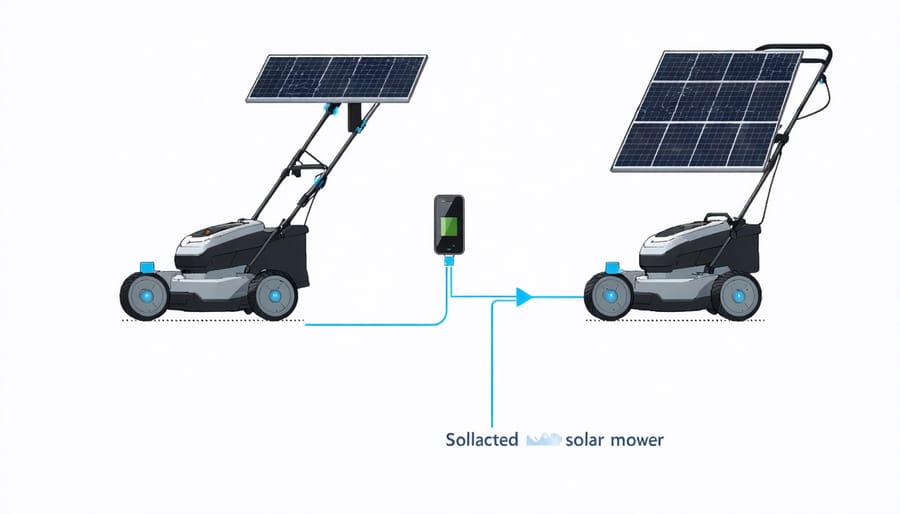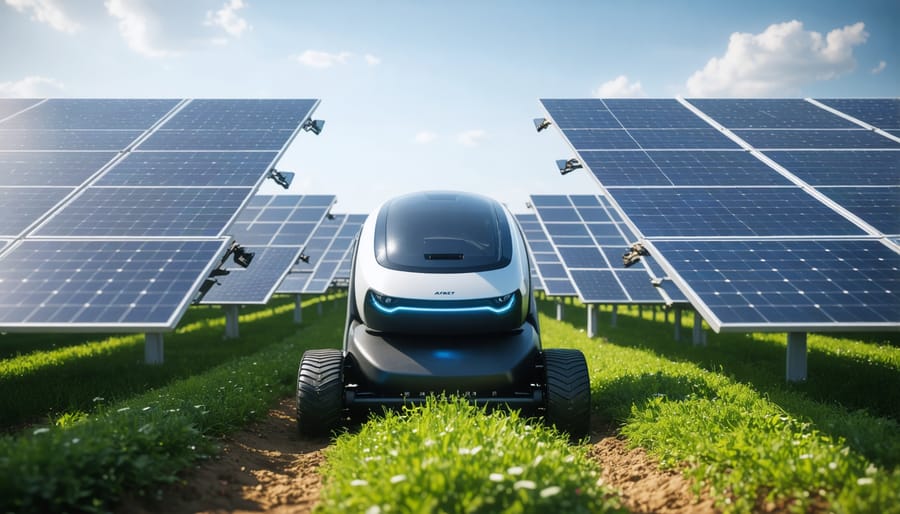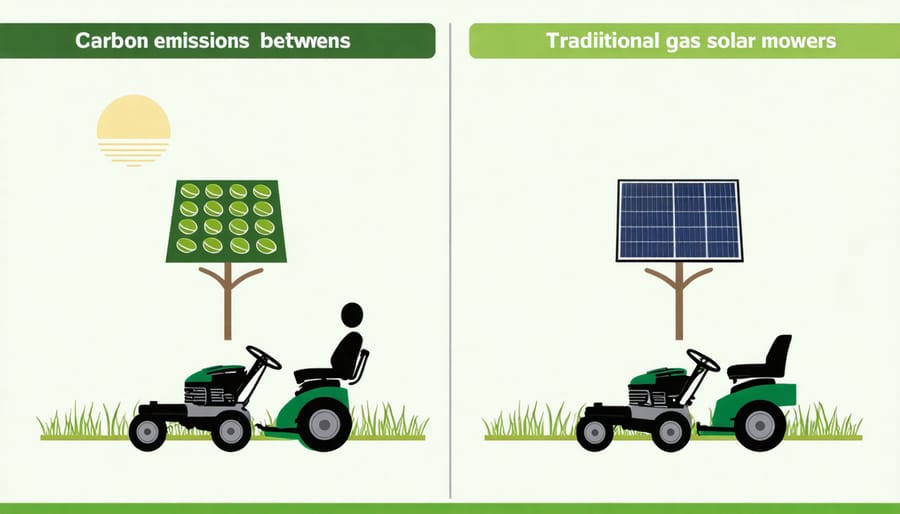Solar Farm Mowers: The Smart Solution for Sustainable Field Maintenance

Revolutionizing solar-powered agriculture, autonomous mowing solutions are transforming how we maintain large-scale solar installations across Europe. These specialized mowers navigate precisely between solar panel rows, combining advanced GPS technology with emission-free operation to maximize energy farm efficiency. Operating silently and powered by the same renewable energy they help produce, solar farm mowers reduce maintenance costs by up to 60% while protecting valuable infrastructure from vegetation overgrowth.
Modern solar mowing systems integrate seamlessly with existing farm management software, providing real-time monitoring and adaptive cutting patterns based on seasonal growth rates. As Europe accelerates its renewable energy transition, these innovative maintenance solutions ensure optimal panel performance while supporting biodiversity through programmed cutting heights and scheduled operations that protect local ecosystems. For solar farm operators seeking sustainable maintenance solutions, these specialized mowers represent the intersection of agricultural innovation and clean energy efficiency.
How Solar Farm Mowers Transform Agricultural Maintenance
Core Technology and Components
Modern solar farm mowers represent a breakthrough in sun-fueled machinery, combining advanced photovoltaic technology with precision cutting systems. At their heart, these mowers utilize high-efficiency monocrystalline solar panels, typically ranging from 200W to 400W, mounted on the mower’s upper surface to maximize sun exposure.
The energy storage system comprises lithium-ion batteries, usually 48V or 72V, with capacities between 2kWh and 4kWh, ensuring sustained operation during cloudy conditions or early morning hours. These batteries incorporate smart charging management systems that optimize power distribution and extend battery life.
The cutting mechanism features hardened steel blades with adjustable heights, powered by efficient brushless DC motors. Most models employ a triple-blade system with cutting widths of 1.2 to 1.8 meters. Advanced sensors monitor grass density and automatically adjust blade speed and cutting height, while GPS navigation systems ensure precise coverage of the solar farm area.
For safety and efficiency, these mowers include obstacle detection systems, slope sensors for stability control, and remote monitoring capabilities through integrated IoT platforms.

Autonomous Operation Features
Modern solar farm mowers incorporate sophisticated autonomous operation features that revolutionise maintenance efficiency. These smart machines utilise GPS navigation systems with centimetre-level precision, enabling them to follow pre-programmed cutting patterns while avoiding obstacles and solar panel structures.
The autonomous navigation system creates detailed digital maps of the solar installation, allowing the mower to operate independently during daylight hours. Integrated sensors detect changes in terrain, vegetation density, and potential obstacles, automatically adjusting cutting height and speed for optimal performance.
Smart scheduling capabilities enable facility managers to programme maintenance routines based on seasonal growth patterns and weather conditions. These systems can coordinate multiple mowers simultaneously, maximising coverage efficiency across large solar installations.
Real-time monitoring through mobile applications provides operators with status updates, performance metrics, and maintenance alerts. The software also tracks cutting patterns and generates detailed reports on vegetation management, helping operators optimise their maintenance strategies.
Safety features include emergency stop systems, anti-theft mechanisms, and automatic shut-off when detecting unauthorised access or unusual obstacles, ensuring reliable operation without constant supervision.

Environmental and Economic Benefits
Reducing Carbon Footprint
Solar farm mowers significantly reduce the environmental impact compared to traditional petrol-powered mowing equipment. While conventional mowers emit approximately 1.5 kg of CO2 per hour of operation, solar-powered alternatives produce zero direct emissions during use. This difference becomes particularly notable when considering the extensive areas that need regular maintenance in solar installations.
A typical solar farm requiring weekly maintenance throughout the growing season would generate around 480 kg of CO2 annually using traditional mowers. By switching to solar-powered mowing solutions, operators can eliminate these emissions entirely. The environmental benefits extend beyond carbon reduction, as solar mowers also eliminate noise pollution and the risk of fuel spills that can harm local ecosystems.
The sustainability advantage compounds when considering the entire lifecycle of the equipment. Solar mowers harness clean energy directly from the installation they maintain, creating a closed-loop system that exemplifies circular economy principles. Additionally, these machines require fewer replacement parts and maintenance intervals compared to combustion engines, further reducing their environmental footprint through decreased manufacturing and service requirements.
For European solar installations, this alignment with EU climate goals and environmental regulations makes solar mowers an increasingly attractive choice for sustainable facility management.

Long-term Cost Analysis
A comprehensive cost analysis reveals that solar farm mowers typically achieve return on investment (ROI) within 3-5 years, depending on the size of the installation and local energy costs. Initial investment ranges from €15,000 to €45,000, but operational costs are significantly lower compared to traditional diesel mowers, averaging just €0.5 per hour versus €4-6 for conventional alternatives.
Maintenance expenses for solar mowers are approximately 60% lower than traditional models, primarily due to fewer moving parts and the absence of complex fuel systems. Annual maintenance costs average €800-1,200, including battery maintenance and blade replacement. The solar panels powering these units typically carry 25-year warranties, ensuring long-term reliability and cost predictability.
When factoring in European carbon taxation and rising fuel costs, solar mowers become increasingly attractive. Operations running 1,000 hours annually can expect savings of €3,500-4,500 in fuel costs alone. Battery replacement, typically needed every 8-10 years, represents the main long-term expense at approximately €3,000-5,000.
Additional financial benefits include potential EU sustainability grants and tax incentives, which can reduce initial investment costs by 20-30%. These factors, combined with minimal daily operating costs, make solar farm mowers an economically sound choice for long-term agricultural operations.
Implementation and Integration
Planning Your Solar Mower System
Planning a solar mower system requires careful assessment and strategic implementation to ensure optimal performance and return on investment. Begin by conducting a thorough site evaluation, measuring the total area that requires mowing and identifying any specific challenges such as slopes, obstacles, or varying terrain types.
Next, analyse your mowing requirements, including frequency, grass types, and seasonal variations. This information will help determine the appropriate battery capacity and solar panel specifications needed for reliable operation. Consider peak sunlight hours in your location and calculate the necessary solar charging capacity to maintain consistent operation.
Document your existing maintenance schedules and costs to establish a baseline for comparing potential savings. Factor in initial equipment investment, installation costs, and projected maintenance requirements when developing your budget. Remember to account for potential incentives and grants available for sustainable agricultural equipment in your region.
Develop a detailed implementation timeline that accounts for delivery, installation, and staff training. Consider starting with a pilot area to test the system’s effectiveness before full-scale deployment. Create contingency plans for backup power sources during extended periods of limited sunlight.
Consult with solar equipment specialists to ensure your planned system meets local regulations and safety standards. They can help optimise panel placement and charging station locations while considering factors like shade patterns and accessibility for maintenance. This professional guidance will help maximise system efficiency and longevity.
Maintenance and Support
Regular maintenance is crucial for keeping solar farm mowers operating at peak efficiency. Daily inspections should focus on checking battery charge levels, blade conditions, and ensuring all solar panels are clean and undamaged. Clean panels with soft cloths and approved cleaning solutions to maintain optimal energy absorption.
Monthly maintenance tasks include thorough cleaning of the mower deck, lubricating moving parts, and inspecting electrical connections. Pay special attention to the motor components and ensure cooling systems are free from debris. The solar charging system should be tested regularly to verify proper voltage output and charging efficiency.
For optimal performance, schedule professional servicing twice yearly, ideally before and after the main mowing season. These comprehensive checks should include battery capacity testing, solar panel efficiency verification, and complete system diagnostics.
Keep detailed maintenance logs to track performance patterns and identify potential issues early. Most modern solar farm mowers come with digital monitoring systems that help schedule maintenance and alert operators to necessary servicing.
To extend equipment lifespan, store mowers in covered areas when not in use, protecting them from harsh weather conditions. Consider investing in protective covers specifically designed for solar panels during extreme weather events.
Professional support services are readily available across Europe, with many manufacturers offering dedicated maintenance contracts and emergency repair services. These support packages often include regular software updates and performance optimization services.
Future Developments and Innovations
The future of solar farm mowing technology is rapidly evolving alongside the agrivoltaics revolution, with several groundbreaking innovations on the horizon. Artificial intelligence and machine learning are being integrated into mowing systems, enabling smarter navigation and predictive maintenance capabilities. These advanced systems can optimize cutting patterns, avoid obstacles, and adjust their operation based on weather conditions and vegetation growth rates.
Remote monitoring and control systems are becoming increasingly sophisticated, allowing operators to manage entire fleets of solar farm mowers from central control rooms. This development is particularly significant for large-scale solar installations across Europe, where efficiency and resource management are paramount.
Emerging battery technologies are set to extend operational times and reduce charging intervals, while new lightweight materials are making mowers more energy-efficient and less damaging to ground surfaces. Some manufacturers are experimenting with hybrid systems that combine solar power with other renewable energy sources, ensuring consistent operation even during periods of limited sunlight.
Environmental sensors and precision cutting technologies are being developed to better protect local ecosystems and wildlife. These innovations include wildlife detection systems and specialized cutting mechanisms that minimize soil disturbance. Additionally, autonomous docking stations powered by solar panels are being designed to create self-sustaining mowing operations, reducing the need for human intervention and increasing overall system efficiency.
Solar farm mowers represent a crucial intersection of renewable energy and sustainable agriculture, embodying the future of eco-conscious farm maintenance. These innovative machines demonstrate how technological advancement can address both environmental concerns and operational efficiency in the solar energy sector. By eliminating emissions, reducing noise pollution, and optimising maintenance costs, solar farm mowers are proving invaluable for European solar installations of all sizes. Their adoption not only supports the renewable energy transition but also creates a complete circle of sustainability, where clean energy powers the very machines that maintain its infrastructure. As the solar industry continues to expand across Europe, these specialized mowers will play an increasingly vital role in ensuring the optimal performance and longevity of solar installations while maintaining the highest environmental standards.
Leave a Reply